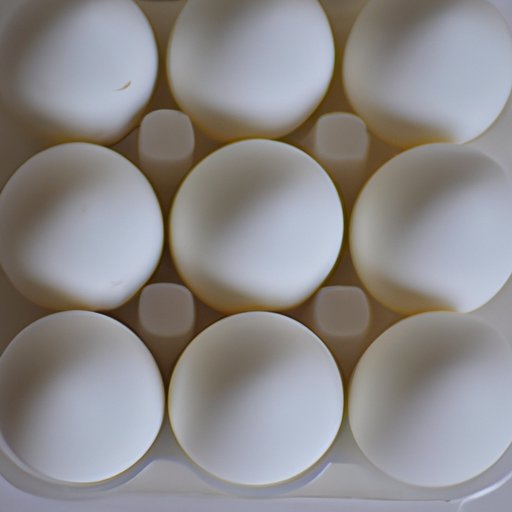
I. Introduction
Do your eggs always end up overcooked or undercooked? Are you tired of throwing out eggs that you just can’t seem to get right? Well, fear not! In this article, we will provide you with a step-by-step guide on how to make the perfect egg, regardless of your cooking skills.
II. Step-by-Step Guide
Before diving into the details, it is essential to understand the importance of following a step-by-step guide. Eggs require precise cooking times, temperatures, and techniques to ensure they attain that perfect texture and flavor. We will walk you through the entire process, from boiling and frying to poaching eggs.
First, identify the type of egg you would like to cook. There are many different varieties of eggs that are cooked differently. For a classic fried egg, heat the pan over medium heat. Add a small amount of butter or oil and crack the egg in the pan. Season with salt and pepper and let the egg cook until the egg whites are set and the yolk is cooked to your liking.
If you prefer boiled eggs, first place the eggs in a pan and fill the pan with cold water, making sure that the water covers the eggs. Bring the water to a boil and let the eggs boil for 5-7 minutes for a soft-boiled egg and 8-10 minutes for a hard-boiled egg. Once the eggs are cooked, immerse them in cold water to stop the cooking process. This will prevent the egg yolk from turning grey.
If you fancy poached eggs, start by bringing a pot of water to boil. Once the water is boiling, reduce the heat to low and add a tablespoon of vinegar. Crack the egg into a cup and stir the water to create a whirlpool. Pour the egg into the water, making sure it is completely submerged, and let it cook for approximately 3-4 minutes. Use a slotted spoon to remove the egg from the water and onto a kitchen towel to drain.
To ensure your eggs cook perfectly, you need to follow some helpful tips, such as using fresh eggs, letting the eggs come to room temperature before cooking, and paying attention to the cooking time.
III. How to Cook Eggs on a Budget
Learning how to cook eggs on a budget is a crucial aspect of managing your grocery budget and reducing food waste. Here are some suggestions:
Substitute expensive ingredients such as milk with water or vegetable broth when cooking scrambled eggs. This will save you money and maintain the fluffy texture and taste of the egg. Another excellent cost-saving technique is using up every last bit of the egg. For instance, eggshells can be used to create compost, and egg whites can be used in baking macarons or meringues.
When it comes to choosing the right eggs, buying at local farmers’ markets and purchasing in bulk can significantly reduce the cost. You can also purchase “graded” eggs, which might look less uniform but are of the same quality as their more expensive counterparts.
IV. Egg-cellent Recipes
If you think eggs are just for breakfast, think again! Eggs are versatile ingredients that can be used to create several recipes. Here are some creative dishes to try:
Egg salad sandwich: Boil eggs and mash them with mayonnaise, salt, and pepper. Spread it in between two slices of bread and add lettuce or tomato, if desired.
Mushroom and spinach frittata: Sauté mushrooms and spinach in a pan until they are soft. Add beaten eggs and let the eggs cook until firm. Place the pan in the oven and broil until the top slightly browns.
Quiche lorraine: Follow the basic recipe for a quiche, which consists of bacon and cheese mixed with beaten eggs. Pour everything into a pie crust and bake in the oven until cooked.
It is your choice to modify these recipes according to your taste. For example, you can add onions or peppers to the egg salad sandwich for extra flavor.
V. Cooking with Eggs
Not only can eggs be stand-alone dishes; they also add flavor, texture, and structure when used in baking and cooking. The possibilities are endless, but here are some examples:
When baking cakes, eggs foster leavening, structure, and moisture. Eggs’ unique properties in macaron-making create the cookie’s signature texture.
Eggs also add depth to savory dishes such as meatloaf and casseroles.
Experimenting with different dishes in which eggs play a vital role can enhance your cooking skills.
VI. Exploring Egg Varieties
Do you know the difference between a free-range and a caged egg? White vs. brown? Here’s a guide:
Free-range eggs are from chickens that are given a space to roam around, resulting in more nutritious and healthier eggs than caged eggs. However, they tend to be costly.
Egg shells’ colors don’t affect the taste or nutrition of the egg, rather where the chicken breeds are what determines the eggshell color. White eggshells are the product of chicken breeds in warmer temperatures, while brown eggshells result from breeding hens in cooler climes.
The different varieties’ nutritional values are relatively similar, but it comes down to your preference, cost, and ethical concerns when purchasing eggs.
VII. Conclusion
We hope that our step-by-step guide to making the perfect egg, along with some valuable tips, cost-saving techniques, and unique egg dishes, will inspire you to cook with confidence. Furthermore, discovering the different egg varieties and their impacts can help you make informed choices when purchasing,eggs. When it comes to cooking with eggs, the possibilities are endless.




